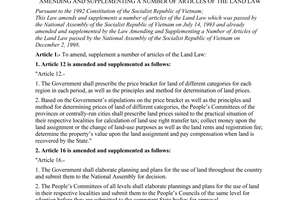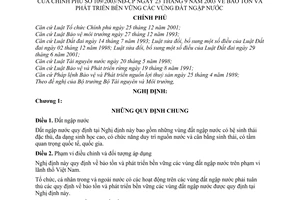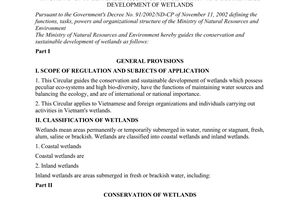Decree No. 109/2003/ND-CP of September 23, 2003, september 23, 2003 on the conservation and sustainable development of submerged areas đã được thay thế bởi Decree 66/2019/ND-CP preservation and sustainable use of wetlands và được áp dụng kể từ ngày 15/09/2019.
Nội dung toàn văn Decree No. 109/2003/ND-CP of September 23, 2003, september 23, 2003 on the conservation and sustainable development of submerged areas
|
THE GOVERNMENT |
SOCIALIST REPUBLIC OF VIET NAM |
|
No: 109/2003/ND-CP |
Hanoi, September 23, 2003 |
DECREE
SEPTEMBER 23, 2003 ON THE CONSERVATION AND SUSTAINABLE DEVELOPMENT OF SUBMERGED AREAS
THE GOVERNMENT
Pursuant to the
December 25, 2001 Law on Organization of the Government;
Pursuant to the December 27, 1993 Law on Protection of Environment;
Pursuant to the July 14, 1993 Land Law, the December 2, 1998 Law Amending and
Supplementing a Number of Articles of the Land Law; and the June 29, 2001 Law
Amending and Supplementing a Number of Articles of the Land Law;
Pursuant to the May 20, 1998 Law on Water Resources;
Pursuant to the August 19, 1991 Law on Forest Protection and Development
Pursuant to the April 25, 1989 Ordinance on Protection and Development of
Aquatic Resources;
At the proposal of the Minister of Natural Resources and Environment,
DECREES:
Chapter I
GENERAL PROVISIONS
Article 1.- Submerged land
Submerged land prescribed in this Decree includes submerged areas which possess peculiar ecological systems and high bio-diversity, have the function of maintaining water sources and ecological balances and are of international or national importance.
Article 2.- Regulation scope and application subjects
This Decree prescribes the conservation and sustainable development of submerged areas in the Vietnamese territory.
Domestic as well as foreign organizations and individuals carrying out activities in submerged areas shall have to observe the provisions on the conservation and sustainable development of submerged areas stipulated in this Decree.
In cases where international treaties which Vietnam has acceded to contain provisions different from this Decree, the provisions of such international treaties shall apply.
Article 3.- Interpretation of terms
In this Decree, the following terms shall be construed as follows:
1. Conservation of submerged areas means activities of zoning and strictly protecting environment and peculiar ecological systems of high bio-diversity in order to maintain the ecological balance and protect various varieties and species living, inhabiting and developing in submerged areas.
2. Sustainable development of submerged areas means activities of rationally using and exploiting potentials for economic, cultural and social development within the allowed limit so as to maintain ecological functions and protect the environment in submerged areas.
3. Peculiar ecological system means the system of peculiar organismic population bearing local characteristics, living and developing together in a given habitat and having interactive relations with one another and with the environment.
4. High bio-diversity means the abundance and diversity of living creatures regarding gene sources, organismic varieties and species and ecological systems in the nature.
5. Ramsar Convention means the abbreviated name of the Convention on submerged areas of international importance, especially habitats of waterbirds, signed in 1971 in Ramsar city, the Republic of Iran (Vietnam became a member of Ramsar Convention as from January 20, 1989).
6. Ramsar zones mean submerged areas meeting all criteria for selection of a submerged area of international importance prescribed in Ramsar Convention.
Article 4.- Principles for the conservation and sustainable development of submerged areas
The conservation and sustainable development of submerged areas must comply with the following principles:
1. Strictly protecting submerged areas zoned by the State for conservation purposes.
2. Linking the use and exploitation to conservation, giving priority to the conservation of submerged areas possessing peculiar ecological systems and high bio-diversity, having the function of maintaining water sources and being of national or international importance.
3. Enhancing the participation in the conservation of submerged areas of population communities living in the localities and vicinities.
Article 5.- State management over the conservation and sustainable development of submerged areas
1. Contents of State management over the conservation and sustainable development of submerged areas cover:
a/ Conducting surveys of, and research into, submerged areas;
b/ Formulating mechanisms, policies and laws for the conservation and sustainable development of submerged areas;
c/ Elaborating plannings and plans on the use of submerged areas for conservation purposes as well as socio-economic development activities;
d/ Managing submerged areas already zoned for protection;
e/ Managing activities of exploiting submerged areas’ resources and potentials in the fields of agriculture, aquaculture, tourism, traffic, irrigation and hydro-power electricity as other fields related to the conservation and sustainable development of submerged areas;
f/ Examining, inspecting and handling violations in the conservation and sustainable development of submerged areas;
g/ Encouraging and creating conditions for the communities, especially people living in submerged areas, to participate in the protection of ecological systems, bio-diversity and environment in the submerged areas;
h/ Entering into international cooperation in the field of conservation and sustainable development of submerged areas.
2. The Government shall exercise the uniform State management over the conservation and sustainable development of submerged areas.
The Ministry of Natural Resources and Environment shall perform the functions of State management over the conservation and sustainable development of submerged areas.
Article 6.- Activities to be encouraged
The State encourages organizations, individuals and population communities to carry out the following activities:
1. Protecting the ecological systems, rare and precious varieties and species, migratory birds and environment in the submerged areas.
2. Restoring submerged ecological systems which have been deteriorated or over-exploited.
3. Participating in supervision of the exploitation of submerged areas by organizations and/or individuals.
4. Detecting and promptly notifying functional agencies of acts of violation of the regulations on conservation and sustainable development of submerged areas.
Article 7.- Prohibited acts
In submerged areas, the following acts are strictly prohibited:
1. Cutting down or destroying submerged forests, carrying out activities which change the natural characteristics, destroying or causing harms to the peculiar ecological systems of submerged areas, causing pollution or degeneration thereto.
2. Catching aquatic and marine animals as well as other animals in egg-laying and brood- and/or larva-nurturing grounds.
3. Exploiting natural resources or building works in new alluvial grounds where submerged forests are regenerated naturally.
4. Using ways of mass extermination such as using electric impulse, explosives, chemicals, toxins and nets with meshes of a size against regulations to catch aquatic and marine animals in submerged areas.
5. Introducing strange animals and plants into the submerged areas’ habitat causing ecological unbalance or changing genes of indigenous animals and plants.
6. Discharging solid wastes, industrial waste water and other kinds of waste containing toxic chemicals, which have not yet been treated or have been treated but fail to meet environmental standards, into submerged areas.
7. Burying wastes and building waste-burying grounds in submerged areas.
8. Activities of causing harms to the interests and life of population communities living in submerged areas and the vicinities.
Chapter II
SURVEYS AND FORMULATION OF PLANNINGS ON CONSERVATION AND SUSTAINABLE DEVELOPMENT OF SUBMERGED AREAS
Article 8.- Contents of surveys of, and research into, submerged areas
Contents of surveys of, and research into, submerged areas cover:
1. Surveys of, and research into, the functions of regulating the surface water and underground water sources, the economic, ecological, cultural and social values as well as bio-diversity of submerged areas.
2. Surveys of, and research into, varieties and species inhabiting, living and developing in submerged areas, especially highly endangered species as well as migratory species.
3. Surveys and evaluation of the practical situation of conservation and development of submerged areas.
4. Sociological surveys of, and research into, population communities earning their living from submerged areas’ resources.
5. The building of a database on submerged areas for use as basis for the formulation of plannings and plans on the use of submerged areas for the purposes of conservation and sustainable development thereof
6. Periodical inventories of the national submerged-land fund according to regions and kinds in service of the management work.
Article 9.- Assignment and decentralization of responsibility for conducting surveys of, and research into, submerged areas
1. The Ministry of Natural Resources and Environment shall formulate master plans on basic survey, research and evaluation of environment of submerged areas nationwide; and assume the prime responsibility in conducting surveys of, and research into, submerged areas of national or international importance which relate many branches and cover many provinces.
2. The Ministry of Agriculture and Rural Development and the Ministry of Aquatic Resources shall organize surveys of, and research into, specialized submerged areas of international or national importance, which cover many provinces.
3. The provincial/municipal Natural Resources and Environment Services shall assume the prime responsibility in conducting surveys of, and research into, submerged areas other than those stated in Clause 1 and Clause 2 of this Article.
Article 10.- Grounds and contents of plannings on submerged areas
1. The planning on submerged areas must be based on the following grounds:
a/ The master plannings on socio-economic development as well as plannings and plans on land use already approved by competent State agencies;
b/ The demands for the conservation and sustainable development of submerged areas;
c/ Ramsar Convention;
d/ The functions of maintaining ecological balance, water sources and bio-diversity as well as economic potentials and advantages of submerged areas.
2. Contents of plannings on the conservation and sustainable development of submerged areas cover:
a/ Determining orientations and objectives of the conservation and sustainable development of submerged areas;
b/ Determining the scope and acreage of submerged areas;
c/ Determining the contents of the conservation and sustainable development of submerged areas;
d/ Determining principal measures for the conservation and sustainable development of submerged areas;
e/ Forecasting and warning on the environment as well as working out measures to prevent, avoid and reduce adverse impacts on environment.
Article 11.- Responsibility to formulate plannings and competence to approved them
1. The Ministry of Natural Resources and Environment shall assume the prime responsibility in formulating plannings on the conservation and sustainable development of submerged areas prescribed in Clause 1, Article 9 of this Decree and submit them to the Prime Minister for approval.
2. The Ministry of Agriculture and Rural Development and the Ministry of Aquatic Resources shall formulate plannings on the conservation and sustainable exploitation of specialized submerged areas prescribed in Clause 2, Article 9 of this Decree and submit them to the Prime Minister for approval.
3. The provincial/municipal Natural Resources and Environment Services shall assume the prime responsibility in formulating plannings on the conservation and sustainable exploitation of submerged areas prescribed in Clause 3, Article 9 of this Decree and submit them to the provincial/municipal People’s Committees for approval.
Chapter III
CONSERVATION OF SUBMERGED LAND
Article 12.- Zoning for protection of submerged areas
1. Submerged areas prescribed in Article 1 of this Decree shall be zoned for protection in the forms of Ramsar zone, nature conservation zone or species and habitat conservation zone (hereinafter referred collectively to as submerged land conservation zones).
2. Other submerged zones which are important to provinces or cities shall be zoned for protection in the form of submerged conservation zone.
Article 13.- Competence to decide on the establishment of submerged land conservation zones
1. The Ministry of Natural Resources and Environment shall propose the Prime Minister to decide on the establishment of submerged land conservation zones prescribed in Clause 1, Article 12 of this Decree.
2. The provincial/municipal Natural Resources and Environment Services shall propose the provincial/municipal People’s Committees to decide on the establishment of submerged land conservation zones prescribed in Clause 2, Article 12 of this Decree.
3. The State agencies competent to decide on the establishment of submerged land conservation zones may decide on the adjustment of the scope and changes in the purposes of submerged land conservation zones.
Article 14.- Protection of submerged land conservation zones
1. Submerged land conservation zones must be strictly protected. The construction of works as well as the migration of people from other places to submerged land conservation zones are strictly prohibited.
2. Buffer areas of submerged land conservation zones must be managed and restricted from exploitation. The construction of works in buffer areas causing great impacts or latent threats to submerged land conservation zones are strictly prohibited.
3. In special cases where it is necessary to build works in submerged land conservation zones and buffer areas, such must be decided by the Prime Minister.
Article 15.- Assignment and decentralization of the responsibility for management over submerged land conservation zones
The management of submerged land conservation zones shall be prescribed as follows:
1. The Ministry of Natural Resources and Environment shall have to elaborate and submit for promulgation or promulgate according to its competence policies and legal documents on submerged land conservation areas; examine and inspect the implementation of policies and legal documents on the conservation of submerged areas and act as the national coordinating agency in directing the implementation of Ramsar Convention.
2. The Ministry of Agriculture and Rural Development and the Ministry of Aquatic Resources shall direct and organize the management of specialized submerged land conservation zones of international or national importance.
3. The provincial/municipal People’s Committees shall organize the management of other submerged land conservation zones in their respective localities.
Article 16.- Conservation of bio-diversity outside submerged land conservation zones
1. Ecological values and bio-diversity of other submerged areas outside submerged land conservation zones must be surveyed and researched for the protection thereof must be worked out.
2. The State encourages organizations, individuals and communities to combine the use and sustainable exploitation of submerged areas with the conservation of bio-diversity thereof.
Chapter IV
SUSTAINABLE DEVELOPMENT OF SUBMERGED AREAS
Article 17.- Responsibilities of organizations and individuals carrying out activities in submerged areas
Organizations and individuals carrying out activities of exploiting resources in submerged areas shall have:
1. To protect peculiar ecological systems and conserve bio-diversity and wild animals, especially endemic, rare and precious varieties and species being in the danger of extinction.
2. To protect saline water-preventing and/or fresh water-retaining works, as well as irrigation works and flood-control systems.
3. To protect landscape, environment, cultural values and historical relics in submerged areas.
Article 18.- Activities of agricultural cultivation
1. To restrict the use of chemical fertilizers, chemicals and plant protection drugs in cultivation, thus degenerating, deteriorating and depleting submerged land, especially coastal estuary land.
2. The State encourages the use of organic fertilizers and microbiological fertilizers as well as the application of farming methods which do not cause adverse impacts on the ecological systems and bio-diversity of submerged areas.
Article 19.- Activities of aquaculture
1. To encourage the application of the aquacultural forms which do not cause adverse impacts on the environment, combine industrial aquaculture with ecological aquaculture and aquaculture after the forestry-fishery or agriculture-fishery models.
2. To restrict concentrated industrial aquaculture covering too large acreage in submerged areas which need to be conserved and sustainably developed.
3. The aquaculture must ensure conditions on sanitation and environmental protection, avoid the spread of epidemics among fauna and flora ecological systems in submerged areas.
Article 20.- Activities of exploring and exploiting earth, stone, sand and gravel
The exploration and exploitation of earth, stone, sand and gravel in submerged areas must be permitted by competent State agencies and comply with the provisions on traffic safety, environmental protection and other relevant regulations.
Article 21.- Tourist, cultural and commercial activities
1. The State encourages the development of ecological tourism and the organization of traditional and folklore festivals in submerged areas with a view to raising people’s sense of protection of nature and environment.
2. Organizations and individuals participating in tourist, cultural and commercial activities in submerged areas shall have to protect natural resources, ecological systems and environment.
3. Activities of organizing festivals, visits and tours in submerged land conservation zones must be consented by, and comply with the guidance of, agencies managing submerged areas.
Article 22.- Activities of work construction
For works built in submerged areas, reports on evaluation of environmental impacts must be elaborated and approved by competent State agencies and the requirements stated in decisions approving reports on evaluation of environmental impacts must be strictly complied with.
Article 23.- Waterway traffic activities
1. Waterway traffic means must have equipment for prevention and combat of incidents; must not discharge assorted wastes and oil dregs untreated or treated below the environmental standards into water sources.
2. For the dredging of riverbeds and channels in submerged land conservation zones, reports on evaluation of environmental impacts must be elaborated and submitted to competent State agencies for approval; the requirements stated in the reports on evaluation of environmental impacts must be strictly complied with.
Chapter V
COMMENDATION, REWARD AND HANDLING OF VIOLATIONS
Article 24.- Commendation and reward
Organizations and individuals recording achievements and exploits in the conservation and sustainable development of submerged areas shall be commended and/or rewarded by the State.
Article 25.- Handling of violations
Organizations and individuals violating the provisions of this Decree shall, depending on the nature and seriousness of their violations, be administratively sanctioned or examined for penal liability; if causing damages, compensation therefor must be made according to law provisions.
Chapter VI
IMPLEMENTATION PROVISIONS
Article 26.- Implementation effect
This Decree takes effect 15 days after its publication in the Official Gazette.
Article 27.- Implementation organization
The Minister of Natural Resources and Environment shall guide the implementation of this Decree.
The ministers, the heads of the ministerial-level agencies, the heads of the agencies attached to the Government and the presidents of the provincial/municipal People’s Committees shall have to implement this Decree.
|
ON
BEHALF OF THE GOVERNMENT |






